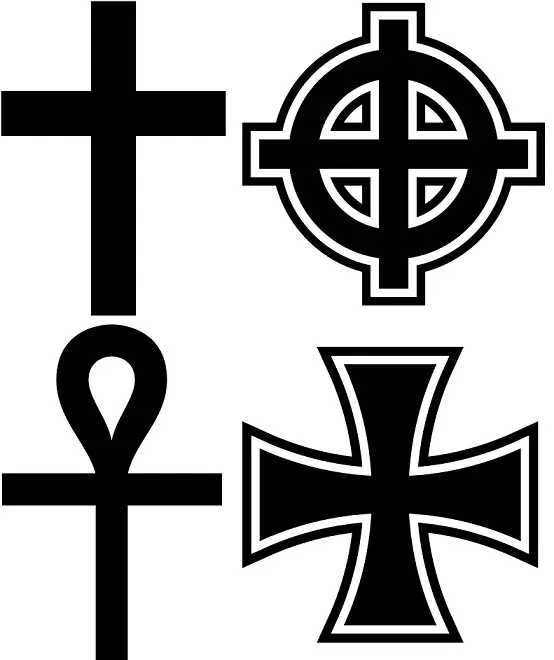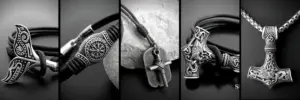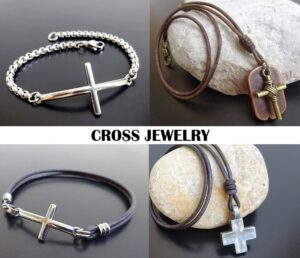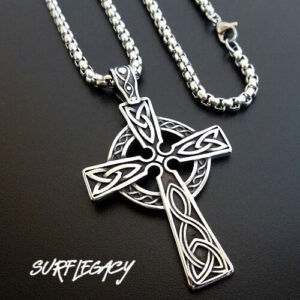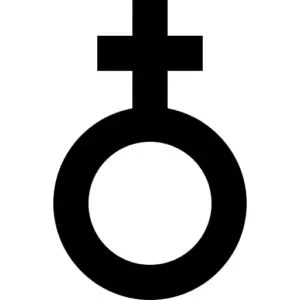The cross is one of the most ancient and universal symbols, and the different types of crosses have special meanings. Used for millennia before Christianity by numerous cultures and religions, today the cross remains a revered symbol of sacrifice, faith, and salvation at the heart of Christianity.
With the incredible depth of history and meaning behind it, the cross has taken on countless forms, variations, and designs over the centuries.
Each cross type carries a unique symbolic meaning and narrative, reflecting the diverse expressions of faith across time and geography.
In this comprehensive guide, we will explore 49 of the most significant types of crosses from around the world. Tracing their origins, purpose, and evolution, we will uncover the rich cultural heritage embodied in these sacred symbols.
From the cosmopolitan Latin Cross to the legendary Celtic Cross, the crusading Jerusalem Cross, and the mystical Coptic Cross, each cross form has its own story to tell.
Read on as we chronicle the tales and symbolism of these emblems, appreciating the tapestry of history interwoven into their lines and form.
49 Types of Crosses And Their Meaning
1 Latin Cross
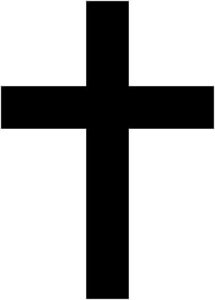
The Latin cross, also known as the Crux Ordinaria or Crux Immissa, is the most familiar cross symbol seen in Christian churches and art. With its long vertical shaft and shorter horizontal bar, it depicts the shape of the wooden cross on which Jesus was crucified.
This common design encapsulates a foundational tenet of Christian theology – the sacrifice of the Son of God to atone for the sins of mankind, paving the way for salvation.
Today, the Latin cross remains the most ubiquitous and instantly recognizable symbol of Christianity found on church steeples, altars, tombstones and sacred artworks across the globe.
2 Greek Cross

The Greek cross features four arms of equal length radiating from a central point, creating a plus sign or square shape. In Christianity, it has represented the global spread of the Gospel message to the four corners of the earth since ancient Byzantine times.
Later adopted by Eastern Orthodox missionaries, it remains a popular cross form associated with Eastern Orthodoxy and Early Christianity. The four equidistant arms symbolize balance, universality and the sweeping reach of Christianity’s teachings.
3 Celtic Cross
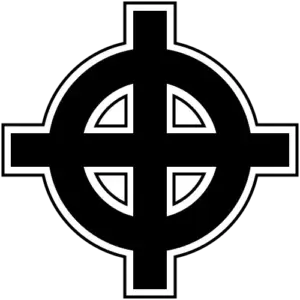
The Celtic cross uniquely merges Christian symbolism with the ancient pagan Celtic veneration of the sun and eternity through the circle. It is characterized by the distinctive circle which intersects with the traditional cross shape.
This iconic form is strongly associated with early medieval Ireland and St. Patrick’s mission to convert the pagans to Christianity. The Celtic cross endures as a prominent symbol of Irish as well as Scottish and Welsh Christian heritage.
Its distinctive shape makes it highly recognizable and it continues to be popular today in Celtic-influenced regions, often used in jewelry, funerary monuments, sculptures and other expressions of cultural and national identity.
4 St. Andrew’s Cross

The St. Andrew’s cross is visually distinctive as a diagonal or X-shaped cross. According to Christian tradition, the apostle St. Andrew was martyred by crucifixion on a cross of this shape since he felt unworthy to die on the same upright cross form as Christ.
The angled shape, known as Saltire in heraldry, made it visually stand out and it became associated with the saint. The St. Andrew’s cross appears on several national flags like Scotland and has been embraced as a symbol of Christian humility and sacrifice.
5 Maltese Cross
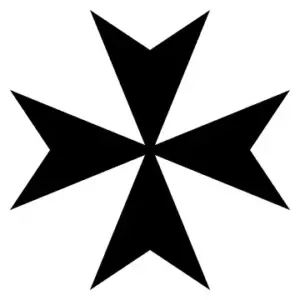
The Maltese cross is defined by the distinctive eight points or arrowheads which taper outward symmetrically from the center. It gained prominence in association with the Knights Hospitaller, a medieval Catholic military order based in Jerusalem that provided hospital and medical care for pilgrims and the injured during the Crusades.
The eight points are said to represent the eight Beatitudes and the high chivalric virtues embodied by the order. The Maltese cross endures today as a recognizable symbol of caring, protection and sacrifice for one’s community. It is a popular emblem used by fire departments, ambulance services, first responders and charitable organizations worldwide.
6 Jerusalem Cross
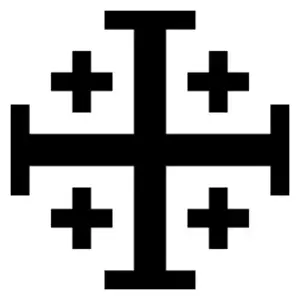
The Jerusalem cross, also called the Crusader’s Cross, is centered around a large Greek cross with four smaller crosses in each quadrant between the arms, totaling five crosses.
It emerged in the 11th century as the emblem of the Kingdom of Jerusalem, after Western European Christians captured the city during the First Crusade.
The five crosses are said to represent the five wounds inflicted on Christ during his crucifixion. Alternatively, the four smaller crosses may signify the worldwide spread of Christianity to all four corners of the earth from Jerusalem.
The Jerusalem cross remains an enduring symbol of the Holy City and a popular form among Crusader historians and medievalists.
7 Cross of St. Peter/Inverted Cross
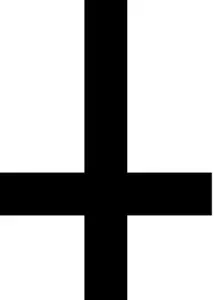
The Cross of St. Peter, also known as the Petrine or Upside Down Cross, is an inverted version of the Latin Cross. According to tradition, St. Peter was martyred in Rome under Emperor Nero and opted to be crucified upside down as he felt unworthy to die in the same manner as Jesus Christ.
While sometimes misconstrued, the inverted cross is an ancient venerated symbol in Christianity representing the humility displayed by St. Peter, considering his own death unworthy of comparison to the sacrifice of Christ.
8 Patriarchal Cross
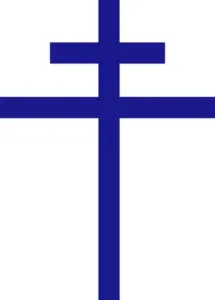
The Patriarchal Cross, also known as the archiepiscopal cross or Cross of Lorraine, is a variation of the Christian cross with two additional horizontal bars near the top.
It originated in Byzantine art and became associated with patriarchs and archbishops of the Eastern Orthodox and Catholic Churches. The two bars are said to represent the plaque bearing the inscription ordered by Pontius Pilate to be fixed above Christ’s head during the crucifixion.
The Patriarchal Cross remains an emblem of seniority and enhanced episcopal authority in high church offices today, with the additional bars demonstrating further venerability.
9 Papal Cross

As a variant of the Patriarchal Cross, the Papal Cross features three horizontal bars decreasing in size from top to bottom. It represents the three distinctive roles and authorities held by the Pope – Bishop of Rome, Vicar of Christ, and successor of St. Peter.
The three bars also ostensibly symbolize the Holy Trinity. While its origins are uncertain, the Papal Cross has been recognized as the unique emblem of the papacy since at least the 13th century, when Popes displayed it on their mantles and it was carried ahead of them in processions.
As it is exclusively associated with the Pope, the Papal Cross denotes the seniority and supreme hierarchy of the pontifical office within Catholicism.
10 Cross of Lorraine

The Cross of Lorraine consists of one long horizontal bar near the top and a shorter horizontal bar near the bottom. It originated as a patriarchal cross in Byzantine culture with early ties to the Eastern Orthodox church.
During the medieval era, it became associated with the Dukes of Lorraine in France and Hungary. Later, it was adopted as the symbol of the Free French Forces led by General Charles de Gaulle during World War II, representing French resistance to Nazi occupation.
Today, the Cross of Lorraine is an emblem associated with patriotism and liberation in France and other Francophone countries. It is also a popular symbol incorporated into the logos of many medical associations and health organizations.
11 Crucifix
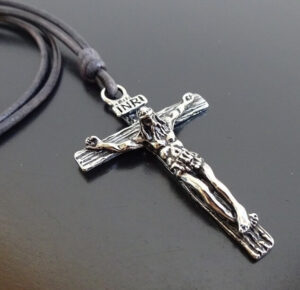
Unlike bare crosses, crucifixes depict the body of the crucified Christ. While both crosses and crucifixes represent Christ’s atoning sacrifice on the cross, crucifixes provide a vivid figural depiction.
They are an important focal point and object of veneration in Catholic and Orthodox traditions, visually encapsulating Christ’s suffering. By contrast, Protestant denominations have tended to favor bare crosses without the figure of Christ, emphasizing Christ’s resurrection and victory over death.
Stylistically, Western crucifixes typically show a three-dimensional body of Christ whereas Eastern Orthodox crucifixes show a two-dimensional painted figure.
12 Tau Cross

The Tau Cross resembles the Greek letter tau, and is thus classified as a cruciform letter representing the cross. Its long association with St. Francis of Assisi and the Franciscan Order has imbued it with particular significance in Christianity.
The Tau cross also predates Christianity as a symbol used in amulets and talismans due to the belief in its divine magical protective powers. Some scholars believe the Tau cross to be the shape of the actual wooden instrument used in Christ’s crucifixion.
Today, it endures as a emblem of St. Francis and the virtues of Christian humility, spiritual awakening, simplicity, poverty and sincere repentance that he embodied.
13 Ankh
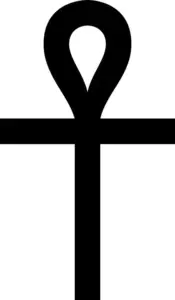
The Ankh is an ancient Egyptian hieroglyph symbolizing life and fertility. It resembles a cross but has an oval loop in place of the top arm. Later adopted by early Coptic Christians, the ankh came to represent eternal life granted by Christ’s sacrifice and the promise of life after death.
While the ankh has more origins in Egyptian history than Christianity, it is today associated with the Coptic Orthodox Church and holds special meaning for Copts as a redemptive symbol of Christ’s gift of life everlasting.
14 Gamma Cross

The gamma cross is formed using four capital gamma letters from the Greek alphabet. The gamma symbol had diverse meanings in ancient cultures, often representing ideas like strength, the divine, and the junction between life and death.
While less commonly seen today, the gamma cross remains a unique emblem consisting of minimalist lines used in certain contexts. For example, in mathematics and physics, the gamma symbol and gamma cross can signify magnetic moment, correlations, or the Lorentz factor. The four gamma letters are also said to represent the four evangelists.
15 Russian Orthodox Cross

Also known as the Suppedaneum cross, this Byzantine-style cross has a slanted footrest near the base and a smaller top crossbar intended to display the sign declaring Jesus the King of the Jews in three languages.
The top bar represents the plaque bearing the inscription ordered by Pilate, while the slanted footrest represents the repentant thief crucified alongside Christ.
The main crossbar is the one on which Jesus’ hands were nailed. The Russian Orthodox cross embodies specific Orthodox Christian beliefs about the crucifixion story with its distinctive accentuating bars.
16 Cross of St. James/Santiago Cross

The Cross of Saint James, also known as the Santiago cross, is a distinctive heraldic badge with a red cross resembling a sword, often shaped as a fleur-de-lis. It gets its name from James the Greater and his role at the Battle of Clavijo in Spain.
This cross is used in Spain and Portugal and has historical connections to religious and military orders in both countries. The three fleurs-de-lis symbolize honor, and the sword represents James’ martyrdom and his role in the Battle of Clavijo, where he is believed to have aided the Spanish king in defeating the Moors.
17 Coptic Cross

The intricate Coptic cross, used predominantly in the Coptic Orthodox Church of Alexandria, Egypt features a central circle representing eternal life which intersects four arms of equal length lined by smaller Coptic crosses.
The twelve stars or points adorning the cross represent the twelve apostles whose message of redemption reaches in all directions. The detailed Coptic cross reflects the Copts’ conviction in the boundless love of God and the abiding hope for salvation shown through Christ’s sacrificial suffering on the cross. It remains a beloved symbol of Egyptian Christianity and Coptic identity.
18 Sun Cross

The idea of the sun cross as a solar symbol has roots in 19th-century scholarship, with interpretations linking it to the sun’s disc and the wheel of the Sun god’s chariot.
The English term “Sun-Cross” is more recent, borrowed from the German “Sonnenkreuz” and gained prominence in the English language in the 1950s.
Historically, “Sonnenkreuz” in German scholarship referred to any cross symbol related to the sun, including equilateral crosses with or without a circle and oblique crosses like Saint Andrew’s cross. It was used in various contexts, including the flag of the Paneuropean Union in the 1920s.
In the archaeological record, sun crosses have been found on Bronze Age artifacts associated with cult practices, suggesting their cultural and religious importance. The symbol’s adaptability is seen in its connection to the four-spoked chariot wheel and its potential solar connotations in cultures that venerated the sun.
19 Bolnisi Cross

The ornate Bolnisi cross featuring curved and widened arm ends is carved into Bolnisi Sioni, an early medieval Georgian cathedral dating back to the 5th century.
The Bolnisi cross inspired later variants like the Iron Cross and Maltese Cross. Its refined style expressed the advent of Christianity in Georgia, exemplifying the Georgian Golden Age of artistic accomplishment and cultural identity.
Georgian crosses were created by architects and sculptors working on the cathedral. Today, the Bolnisi cross remains a national symbol of Georgia and a testament to the Christianization of the region.
20 Crosses of Merit
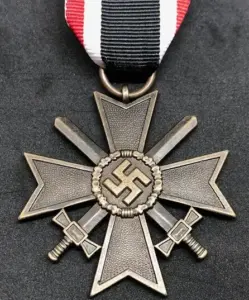
The crosses of merit, predominantly found in lands once part of the Byzantine and Holy Roman Empires, represent honors conferred by Christian chivalric orders or civil state merit orders rather than religious symbols per se. For example, the Cross of Honor of the German Order denotes service to Germany.
These enameled gold crosses worn on neck ribbons follow the Maltese cross model and are similar to military medals. While cruciform, they are secular emblems awarded for state, civil or military service rather than religious devotion.
21 Marian Cross

The Marian Cross, also called a Christogram, introduces the letter M symbolizing the Virgin Mary on the cross, thereby explicitly linking Mary and Jesus. In recent centuries, Popes have promoted Marian crosses to honor her role in Christ’s life and passion.
Pope John Paul II also championed its use, stating, “the Marian Cross represents the Cross of Christ, the letter M recalls the presence of Mary beneath the Cross.” While a relatively new symbol, it celebrates the special veneration of the Virgin Mary in Catholicism and her undying maternal protection and intercession.
22 Cross Botonée/Budded Cross
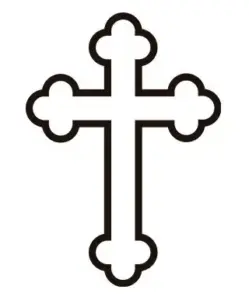
The Cross Botonée, prevalent in medieval heraldry and church ornamentation, features each arm ending in a trefoil or budded pattern. The name comes from the French ’bouton’ meaning bud or button, referring to the bud-like squared ends.
The three-part budded ends mirror the Holy Trinity, with each lobe representing the Father, Son and Holy Spirit respectively. The Cross Botonée remains recognizable in church art and architecture for its distinctive form accented by rounded trefoil ends.
23 Cross Barby/Voided Cross

The Cross Barby is distinguished by the diamond-shaped perforations or voids in place of a solid center, creating a striking visual effect. The openings ostensibly represent the wounds of Christ and allow the background to show through.
The Cross Barby was frequently used in heraldry and on coats of arms due to its attention-grabbing negative space. Also known as Cross Voided or Cross Pierced, the openings add intrigue and artistic intricacy.
24 Cross of Salem

The Cross of Salem adds a Star of David to a Tau Cross, symbolizing peace and reconciliation between Christians and Jews. The name Salem refers to the heritage of Jerusalem, cited in Psalm 76:2.
This modern emblem was adopted by the World Council of Churches, encouraging interfaith dialogue. By integrating Judaism’s primary symbol, the Star of David, with a classic Christian Tau cross, it conveys unity and harmony between the two related faiths.
25 Cross and Crown
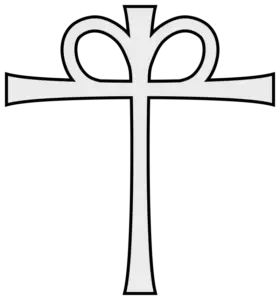
The cross and crown motif featuring a crucifix atop a crown or ring of thorns is widely employed as a symbol in Christianity, particularly in Methodist and other Protestant traditions.
It carries dual meaning, reminding believers of Christ’s willing sacrifice and suffering which resulted in the ‘crown of life’ or eternal reward in heaven. This emblem reinforces the concepts of temporary earthly trials and tribulations faced when following Christ, offset by the promise of eventual glory.
26 Irish High Crosses
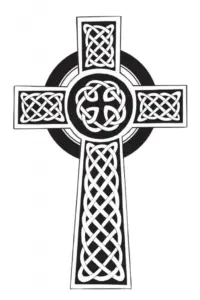
Irish high crosses are monumental stone Celtic crosses featuring lavish carved biblical iconography and intricate scrollwork on the faces of the cross itself. These ornate Irish medieval crosses visually recounted scripture for the illiterate.
Their elaborate Celtic interlacing patterns and clearly carved biblical scenes on all sides were a vehicle for monks to vividly teach biblical stories to the laypeople and newly converted pagans.
The motifs also connect Old Testament prophets like Abraham and Isaac to Christ’s later sacrifice, uniting separate eras and testaments.
27 Calvary Cross

Calvary, Golgotha, or the Hill of Skulls was the site just outside Jerusalem where Jesus was crucified. Calvary crosses depict this by standing on three stages representing the three places where Christ was; the upright, the Suppedaneum, and the Base.
The steps leading up to the crucifixion are emblematic of Christ’s final journey and the Stations of the Cross. This form vividly recreates the historical events on Golgotha and remains an important symbol of Christ’s Passion.
28 Anchor Cross

Early persecuted Christians disguised crosses as anchors to avoid detection when held upside down. The anchor cross features a traditional Latin cross with anchor flukes curving around the bottom to create a subtle Christian symbol that could be easily concealed.
The anchor also symbolized hope and steadfastness in times of persecution and remains associated with these qualities today. The maritime connotations of the anchor cross make it a popular symbol among seafaring Christians and naval churches.
29 Cross of Sacrifice
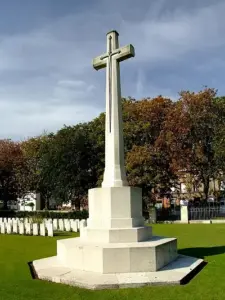
Designed by Sir Reginald Blomfield for Commonwealth war cemeteries, the Cross of Sacrifice honors the fallen with a starkly somber form envisioned to imbue loss and courage.
Featuring a long tapering shaft and shorter yet wider splayed crossbar, its angularity evokes the jagged destructive essence of war. The cross is mounted on an octagonal base accompanied by a bronze decorative sword of sacrifice.
Its grave simplicity conveys bereavement, while valorizing those who sacrificed their lives fighting for Britain and its allies.
30 Occitan Cross
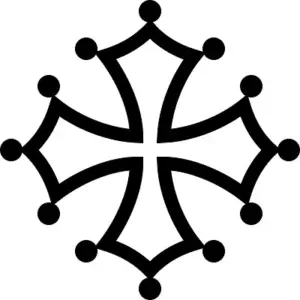
The Occitan cross was originally the Counts of Toulouse’s family emblem before becoming a symbolic rallying emblem of Occitania, the lands where Occitan languages are spoken in southern France. It features a cross with distended ends, with 12 balls or studs on the edges ostensibly representing the 12 apostles.
The cross was adopted as a symbol of Occitan pride and cultural identity during 20th century Occitan nationalism movements. While lacking specific religious symbolism, its ties to regional history have imbued it with importance for Occitan patrimony.
31 Cross Fitchy/Cross Fitchee
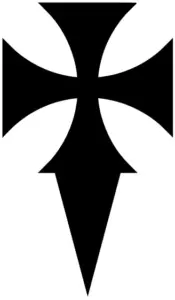
The Cross Fitchy or Cross Fitchee has a distinctively sharpened and pointed lower vertical arm which allows it to be planted or fixed in the ground, like a blade. The pointed arm is said to represent being anchored and rooted in unwavering conviction and faith.
Alternatively, the pointed base anchored into the earth while the upper arms reach to the heavens is said to represent earthly human life and mortality juxtaposed with higher divine aspirations. Its basic portable design made it highly popular with Crusaders on their journeys.
32 Cross Pommee
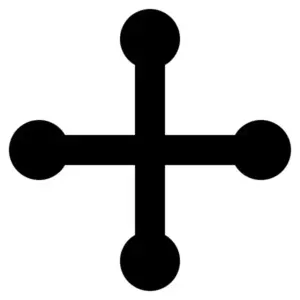
The Cross Pommee ends each arm with a round knob or ball shape rather than a pointed tip, which in heraldry is termed a pomme and represents an apple.
This style of terminus emulates fruits, flowers, nuts or severed heads in medieval manuscript illustrations. Introducing natural circular endings softens the overall look and feel of the cross shape.
The Cross Pommee was frequently employed in coats of arms, insignia and heraldic badges in the medieval period.
33 Iron Cross
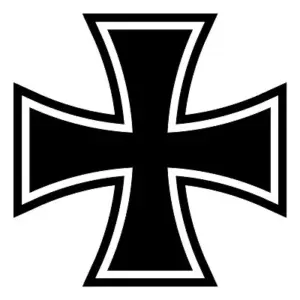
The Iron Cross, known as Eisernes Kreuz in German, holds a significant place in German military history. Originating in the Kingdom of Prussia, it later became a distinguished decoration in the German Empire and Nazi Germany.
Its design, featuring a black cross pattée outlined in white or silver, draws its inspiration from the emblem of the medieval Teutonic Order, used by its knights from the 13th century. Initially established by King Frederick William III of Prussia during the Napoleonic Wars, the Iron Cross has been awarded during key historical periods, including the Franco-Prussian War, World War I, and World War II.
In World War II, the Nazis added a swastika to their version of the medal. While primarily a military decoration, some civilians, such as test pilots Hanna Reitsch and Melitta Schenk Gräfin von Stauffenberg, received the honor for their contributions in military roles.
In modern times, the Iron Cross remains emblematic of the Bundeswehr, the contemporary German armed forces. Its historical legacy extends to the outlaw motorcycle subculture and heavy metal fashion, further enhancing its iconic status. The Iron Cross has truly left an indelible mark on German history and symbolism.
34 Cross of St. George
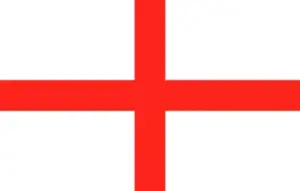
Saint George’s Cross, also known as the Cross of Saint George in heraldry, is a red cross on a white background. This iconic emblem, closely associated with Saint George, the patron saint of England and a renowned military figure depicted as a crusader, has a rich historical background. Its roots trace back to the 10th century, and it was used as the ensign of the Republic of Genoa from that time.
The symbol gained prominence during the era of the crusades, eventually becoming a recognizable insignia of crusaders by the late 12th century, often seen alongside the Jerusalem Cross. Saint George’s Cross is now widely acknowledged as the national flag of England, replacing St. Edmund the Martyr in the 14th century.
It also holds significance in regions such as Catalonia and the country of Georgia, where Saint George is revered. The red cross’s origins are connected with the Knights Templar and the Kingdom of Aragon. Over time, it became associated with Saint George, whose depiction as a crusader knight with the red-on-white cross dates back to the late 13th century.
Edward III of England chose Saint George as the patron saint of the Order of the Garter in 1348, solidifying the cross’s association with England. While there are historical claims linking the flag to Richard the Lionheart’s adoption from Genoa during his crusade, these have been contested.
The red cross was worn by English soldiers for identification in the late 13th century and became intertwined with Saint George’s identity as the patron saint of England in the 14th century. Since then, it has been a prominent element in the Royal Standards of the English monarchy. Saint George’s Cross represents a powerful historical and cultural symbol in England and beyond.
35 Forked Cross
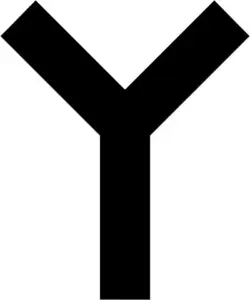
A forked cross, also known as a Y-cross or mystic’s cross, originated in the late 13th or early 14th century under the influence of mystics. It is commonly found in the German Rhineland, where it’s called a Gabelkreuz, Mystikerkruzifix, Schächerkreuz, or Pestkreuz.
This unique cross is believed to symbolize the Tree of Knowledge, which brought sin into the world but was overcome by Jesus’ suffering on the cross. The image of Christ on the forked cross is intended to be starkly disturbing, emphasizing his agony and sacrifice.
These crosses often appear in Dominican and Franciscan communities. They gained special significance during the Counter-Reformation, and some may depict the two thieves on the forked cross while Jesus is on a straight beam, hence the alternative name “robber’s cross” or “thief’s cross.” ù
While the crucifix in St. Mary’s in the Capitol, Cologne, was once considered the oldest forked crucifix, recent restoration work revealed it wasn’t the prototype. It’s uncertain if these crosses were made by local craftsmen, possibly being imported or crafted by itinerant artists. Other examples can be found in various locations in Germany, like Haltern, Bocholt, Borken, Coesfeld, and several churches in different regions.
36 Globus Cruciger
The globus cruciger, also known as “the orb and cross,” is a Christian symbol of authority with historical significance dating back to the Middle Ages. It consists of an orb topped by a cross and has been used on coins, in iconography, and as part of royal regalia with a scepter.
This symbol represents Christ’s dominion over the world, emphasizing the union of spiritual and earthly power. When Christ is depicted holding the globe, he is referred to as Salvator Mundi, the Saviour of the World. For instance, the 16th-century Infant Jesus of Prague statue holds a globus cruciger in this manner.
The use of holding the world or placing it under one’s foot has been a symbol since ancient times. In Roman times, the globe held by Jupiter symbolized the universe, much like the dominion held by the Emperor. With the growth of Christianity in the 5th century, the orb was surmounted with a cross, signifying God’s dominion over the world.
The Emperor holding the world in his hand represented his rule on behalf of God, while the cross atop the orb symbolized Christianity’s victory over the world, signifying the union of spiritual and earthly power.
This symbol adorned the iconography of powerful rulers, angels, and was featured on coinage, in royal regalia, and the papal tiara during the Middle Ages. It also served as the finial on European royal crowns, including those of Denmark, the Holy Roman Empire, Hungary, Italy, the Netherlands, Portugal, Romania, Spain, Sweden, and Yugoslavia.
Even in contemporary times, it continues to hold significance in the arms of some European nations and symbolizes the state and Church of England under the monarchy’s protection.
37 Troll Cross
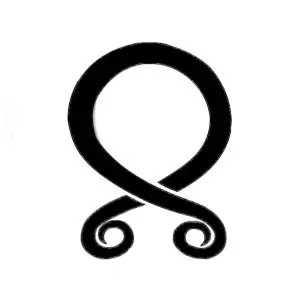
In Sweden and Norway, a trollkors, or troll cross, is a unique bent piece of iron worn as an amulet to ward off malevolent magic. It has its roots in medieval Sweden and is believed to represent the Norse symbol of protection. Those who wear it trust that it can reduce their chances of encountering danger.
While it is commonly associated with Swedish folklore, the troll cross was actually first created as a piece of jewelry by the smith Kari Erlands in western Dalarna, around the late 1990s. It was claimed to be a replica of a protective rune discovered at her grandparents’ farm, although this claim remains unverified.
Although it bears some resemblance to the othala rune in Elder Futhark and Anglo-Saxon runic writing systems, it’s more likely that Erlands mistook a Bumerke for a protective symbol.
38 Cross erminée

A cross erminée is a unique heraldic cross featuring four ermine-spots, where the heads of these spots meet, sharing their distinctive pattern. This particular cross design has historical significance and was notably borne by the Hurston family from Cheshire, England, around the year 1490.
The ermine-spots, often associated with aristocratic or noble families, contribute to the cross’s intricate and distinctive appearance, creating a visual representation of historical lineage and heritage.
Ermine spots, characterized by their black tails on a white field, have a rich history in heraldry, symbolizing purity and nobility. The cross erminée, with its unique arrangement of these spots, serves as a symbol of distinction and heritage, telling a story of the family or individual it represents. The use of such a cross in heraldry reflects a connection to tradition and a sense of pride in one’s lineage.
39 Cross Avellane

In heraldry, an avellane cross is a unique cross design that closely resembles four hazel filberts, still encased in their husks or protective cases, seamlessly joined at their broader ends. The term “avellane” itself is derived from the Latin name for hazel, known as “Nux avellana” in the past. While this distinctive cross design was relatively rare in English heraldry, its visual representation holds historical significance.
The avellane cross, with its striking resemblance to hazel filberts, carries a symbolic connection to nature, potentially signifying qualities like growth, protection, or even a connection to the land. In heraldry, symbols often hold deep meanings and convey a sense of identity or history.
40 Leviathan Cross
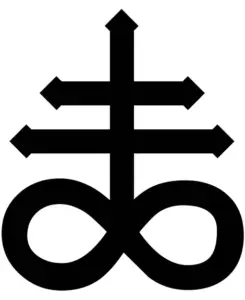
The Leviathan Cross, also known as the Cross of Satan or the Satanic Cross, is a symbol associated with modern Satanism. It consists of a cross with a large loop atop it, resembling an infinity symbol. The symbol’s origin can be traced back to the Sigil of Baphomet, an emblem associated with the Church of Satan, founded by Anton LaVey in the 1960s.
The Leviathan Cross is often used by some Satanic groups as a representation of their beliefs and principles. It’s important to note that different Satanic organizations may have varying interpretations of this symbol and its meaning. To some, it may symbolize the dualistic nature of existence or the balance of opposites.
While the Leviathan Cross has a sinister reputation due to its association with Satanism, it’s essential to understand that its interpretation can vary widely among individuals and groups.
41 Cross Crosslet

The Crosslet Cross, a distinctive heraldic cross, is characterized by the arrangement of four Latin crosses, each set at right angles to one another. Another variation of this cross is formed from one Greek Cross with small crosses positioned at the end of each of its arms.
These small crosses atop the main cross are orientated in different directions, symbolizing the cardinal points: north, south, east, and west.
One of the most prevalent interpretations of the Crosslet Cross is its association with the four evangelists, namely, Matthew, Mark, Luke, and John.
The alignment of the small crosses echoes the evangelists’ roles in spreading the Christian message to different parts of the world, making it a symbol of world evangelism.
This interpretation resonates with the concept of the Mission Cross, making the Crosslet Cross an alternative representation of global missionary efforts.
The Crosslet Cross is also referred to as the Crossed Cross due to its unique configuration. It is not exclusive to this form but can be found on other missionary crosses like St. Julian’s Cross.
This heraldic symbol has deep historical and religious significance and is celebrated in the world of heraldry for its distinctive design and representation of faith.
42 Cross of Calatrava
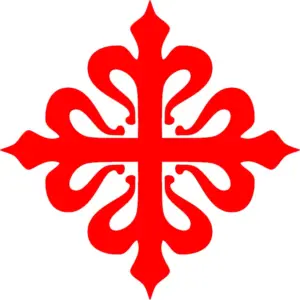
The Calatrava Cross is a prominent symbol among the Iberian orders of knighthood in Spain and Portugal, with roots dating back to the 12th-century Military Order of Calatrava.
Originally, the Knights Templar were a small group formed in 1118 to protect pilgrims traveling to Jerusalem. As their influence grew, they adopted their distinct white Cistercian robe with a red cross. In 1147, the Knights Templar were invited to protect the Calatrava castle, which was later retaken by Moors. They eventually reclaimed it and expanded across Iberia.
Their symbol, the Calatrava Cross, features a white mantle with a scarlet Greek Cross ending in Fleur-de-lis shapes resembling the letter ‘M,’ representing devotion to the Virgin Mary.
Surprisingly, this historic symbol was adopted as the logo for the luxury Swiss watch company Patek Philippe, bridging the gap between medieval knights and modern luxury.
While their original mission may not be fully realized, the Calatrava Cross remains a powerful and enduring symbol with a remarkable journey through time.
43 Saint Patrick’s Cross
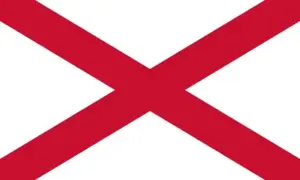
Saint Patrick’s Saltire, a red saltire on a white field, is a symbol closely associated with Ireland. Although its origin is disputed, it gained prominence when the Anglo-Irish Order of Saint Patrick adopted it as their emblem in the late 18th century. This order was established in 1783 by King George III and was used to reward those who supported the Anglo-Irish government.
The choice of a red saltire for St. Patrick led to controversy because it differed from the traditional crosses used on St. Patrick’s Day. Some argued that the red saltire resembled the Cross of St. Andrew, the patron saint of Scotland. Despite these debates, it became a widely recognized symbol of Ireland.
The use of the red saltire extended beyond the Order of Saint Patrick and, with the Acts of Union in 1800, was incorporated into the Union Flag of the United Kingdom, representing Ireland. This design is still used in the modern Union Jack. In Northern Ireland, where flags can be contentious due to political and sectarian divisions, St. Patrick’s Saltire is sometimes used as a less politically charged symbol.
It’s important to note that various forms of crosses have been associated with St. Patrick and Ireland throughout history, and the red saltire continues to be part of Irish symbolism.
44 Chi Rho Cross
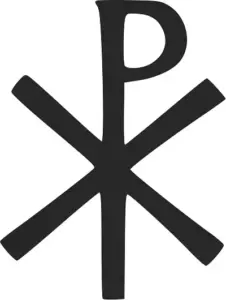
The Chi-Rho symbol (☧) is a combination of two Greek letters, Chi (Χ) and Rho (Ρ), forming a symbol resembling an X placed over the stem of the letter P. These Greek letters are the initial letters of the Greek word “Χριστῷ,” which translates to “Christ” in English.
The Chi-Rho is often referred to as the Christogram because it represents Christ through this monogram. This symbol gained prominence as a representation of Christ’s name during the reign of Constantine in the fourth century AD.
Historian Eusebius tells the story of how Constantine used this symbol during his quest for military victory. When Constantine realized the importance of honoring his father’s God alone to ensure victory, he saw a vision of the cross in the sky with the inscription “By this symbol, you will conquer.”
Later, Constantine had a dream in which Christ instructed him to use this symbol as a protective emblem in battle. This emblem was known as the Labarum and was used by other Christian emperors as well.
The Chi-Rho symbol, although not mentioned in the Bible, is widely used in Christian symbolism. It is often depicted with the Greek letters Alpha (Α) and Omega (Ω) on either side, signifying Jesus Christ as the Alpha and Omega, as mentioned in the Book of Revelation.
The Chi-Rho symbol is one of the earliest Christograms, and it has been used for centuries to acknowledge Christ. It was employed by Roman Emperor Constantine as a symbol of divine protection for his soldiers in battle. The Chi-Rho, often enclosed within a circle or wreath, represents Christ’s victory over death and His resurrection.
While the Chi-Rho is a powerful symbol of Christ, it should not be used as a talisman, amulet, or charm, as it would cross into superstition and deviate from its intended purpose.
In the ancient world, it became an official part of imperial insignia, appearing on the helmets of some Late Roman soldiers and on coins and medallions during Constantine’s reign.
By the fourth century, it was commonly used on Christian sarcophagi and frescoes. This symbol played a significant role in the spread of Christianity and its connection to the Roman Empire.
45 Golgotha Cross
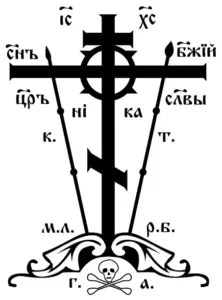
The Golgotha Cross is a significant Christian symbol representing Jesus’s crucifixion and forgiveness. It resembles the Greek Orthodox cross but has an additional shorter arm above the crossbar. This cross features the Lance of Longinus on one side and the sponge on a stick with vinegar on the other, given to Jesus before his death.
At the base is a skull representing the hill of Golgotha where the crucifixion took place. The inscriptions on the cross are in different languages describing Jesus as king, and how Golgotha went from a place of death to paradise.
The cross shape likely had a short vertical beam crossed by two smaller horizontal beams, allowing a sign listing Jesus’s supposed crimes to be placed above his head. Though the exact design is uncertain, the Golgotha Cross remains an important symbol of Christ’s sacrifice and God’s mercy.
46 Nordic Cross
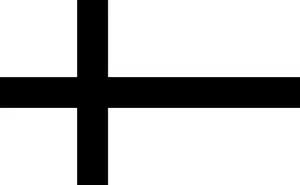
The Scandinavian or Nordic cross is a distinctive design feature found on the national flags of the Nordic countries of Denmark, Finland, Iceland, Norway, and Sweden. This offset cross pattern likely originated in medieval Scandinavia as a Christian symbol, with the oldest known example being Denmark’s Dannebrog flag dating back to the 13th century.
Over time, other Nordic countries adopted variations of the cross for their own flags, aligning themselves with Christian Denmark and Sweden. Beyond national flags, the cross is also incorporated into Nordic sub-national, regional, and organizational banners. For instance, the Åland Islands and Finland’s armed forces use the pattern in their flags.
Additionally, former territories like the Shetland and Orkney Islands off Scotland have their own Nordic cross flags, emphasizing the historical influence of Norse culture. The flags form a cohesive Nordic family, representing shared regional heritage. However, each design also asserts national identity, as the Nordic countries eventually claimed independence and sovereignty over the centuries.
47 Grapevine Cross

The Grapevine Cross, also known as the Georgian Cross or Saint Nino’s Cross, dates back to the 4th century when Christianity became the official religion of the Kingdom of Iberia (now parts of Georgia and Turkey). This unique cross is characterized by its drooping arms and is a significant symbol in the Georgian Orthodox Church.
Legend attributes the design to Saint Nino, a key figure in spreading Christianity in the region. According to tradition, she either received the cross from the Virgin Mary or crafted it herself, securing it with her hair. It wasn’t until later that the distinctive drooping-arm form of the cross became prominent.
Throughout history, the cross had various homes, including Svetitskhoveli Cathedral in Mtskheta and later in Armenia, where it remained during Persian invasions. It was brought back to Georgia in the 12th century and has been preserved at Sioni Cathedral in Tbilisi since it was returned from Russia in 1802. This cross is a symbol of faith and the enduring connection of the Georgian people to their Christian heritage.
48 Templar Cross
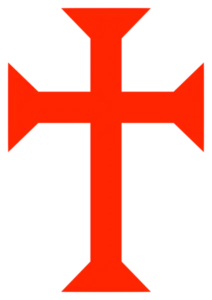
The Templar Cross, also known as the Cross Pattée, holds significant meaning. It was associated with the Knights Templar, a renowned medieval organization, tasked with protecting Christian pilgrims and the Holy Land. The history of the Templar Cross begins with its creation in the 12th century.
The Templar Cross visually resembles a Greek cross, featuring arms of equal length and distinct red and white colors. It differs from the Maltese Cross, although they are often confused. Its significance was multi-faceted:
- Use on the Battlefield: Worn proudly by the Knights Templar during battle, the cross symbolized martyrdom. The knights believed in an assured place in paradise, removing fear of death and emphasizing honor and glory. Strict military rules required knights to stand by their comrades as long as the Templar flag flew.
- Christian Symbolism: From a Christian perspective, the cross represents the sacrifice of Jesus Christ on the cross, conveying love and compassion. The Knights Templar, dedicated to defending Christianity and the Holy Land, used this cross to align themselves with the church’s teachings.
- Crown Association: Often paired with a crown, the cross suggests heavenly rewards for a life well-lived. It signifies that one’s journey is not finite, and honor can still be achieved beyond death. The Latin phrase “In Hoc Signo Vinces” translates to “By this sign you shall conquer,” reinforcing the idea of ultimate victory.
The origin of the Templar Cross is multifaceted and has deep historical roots. It may be linked to ancient alphabets, particularly Hebrew, where the cross represents finality and judgment. Another theory suggests its connection to the mark of Cain, found in the Bible’s Book of Genesis.
The symbol of the Templar Cross is rich with meaning, reflecting a blend of Christian beliefs, military valor, and the quest for divine rewards. Its origin, deeply intertwined with history, carries multiple interpretations that continue to intrigue and inspire.
49 Cross Potent
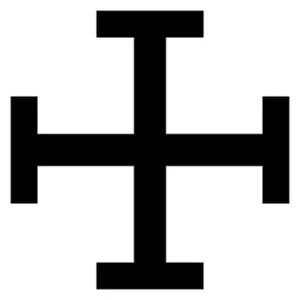
The Cross Potent, also known as the Crutch Cross, is a heraldic cross characterized by crossbars at its four ends. Its name, “Potent,” derives from the word for a crutch. This cross variation is identified as the “Jerusalem cross” due to its association with the Kingdom of Jerusalem in heraldic literature.
The history of the Cross Potent extends to ancient times. Its shape appears in pottery decorations during the European and Chinese Neolithic periods. In Chinese bronze inscriptions, it symbolizes a divining rod used in shamanistic practices. As a Christian cross variant, the Cross Potent was found on Byzantine coins, mainly in the form of a “Calvary cross potent” during the 7th century.
Early heraldic usage showed crosses to the edges of shields as ordinaries, but variations in the termination of cross limbs became common in the late 13th century. Notably, it featured in the coat of arms of the Kingdom of Jerusalem. However, use of the Cross Potent remained rare in heraldry beyond the Jerusalem cross.
The Cross Potent was revived in the 19th and early 20th centuries and used as an emblem for Roman Catholicism. In modern times, it finds its place in the symbols of many Roman Catholic Scouting and Guiding organizations. Notably, it was adopted by the Austrian First Republic and served as a counter-symbol to the Nazi swastika and the communist hammer and sickle.
Today, the Cross Potent is incorporated into the coats of arms of entities like the Santa Cruz Department in Bolivia and the Wingolf Christian student fraternities in Germany, Austria, and Estonia. It continues to hold significance in various modern contexts, such as in the flags and logos of certain organizations.
Summary Table of Cross Types and Meanings
| Cross-Type | Meaning |
|---|---|
| Latin Cross | Represents Christ’s crucifixion and sacrifice for salvation. Most common Christian cross. |
| Greek Cross | Represents global spread of the Gospel to the four corners of the earth. Symbol of balance and universality. |
| Celtic Cross | Combines Christian cross with pagan Celtic sun worship. Represents Irish, Scottish, Welsh Christian heritage. |
| St. Andrew’s Cross | Symbolizes apostle St. Andrew’s martyrdom and humility. He felt unworthy to die on same cross as Christ. |
| Maltese Cross | Emblem of Knights Hospitaller that protected pilgrims. Represents care, protection and sacrifice for community. |
| Jerusalem Cross | Emblem of Crusader Kingdom of Jerusalem. Represents Christ’s 5 wounds, or global spread of Christianity from Jerusalem. |
| Cross of St. Peter | Symbolizes apostle St. Peter’s humility in requesting to be crucified upside down, feeling unworthy of same death as Christ. |
| Patriarchal Cross | Denotes seniority of Eastern Orthodox and Catholic patriarchs and archbishops. Two extra bars represent plaque above Christ’s head. |
| Papal Cross | Symbolizes Pope’s triple authority as Bishop of Rome, Vicar of Christ, and successor of St. Peter. |
| Cross of Lorraine | Originally Byzantine Orthodox symbol, later associated with liberation in France during WWII when used by Free French Forces. |
| Crucifix | Depicts crucified body of Christ, focal point in Catholic/Orthodox veneration contrasting bare crosses favored by Protestants. |
| Tau Cross | Shape resembling Greek letter tau. Associated with St. Francis and virtues of Christian humility, repentance, simplicity. |
| Ankh | Ancient Egyptian symbol adopted by Coptic Christians to represent Christ’s gift of eternal life. |
| Gamma Cross | Formed by 4 Greek gamma letters. Said to symbolize the 4 evangelists, or divine magical power in ancient cultures. |
| Russian Orthodox Cross | Extra slanted and shorter crossbars represent repentant thief crucified with Christ and plaque declaring Jesus as King. |
| Cross of St. James | Symbol of Order of St. James in Spain/Portugal. Red cross resembling sword represents military Order’s crusader heritage. |
| Coptic Cross | Intricate shape with circle represents eternal life and smaller Coptic crosses represents Christ’s boundless love. Symbol of Egyptian Coptic heritage. |
| Sun Cross | Linked to ancient pagan sun worship and Bronze Age European artifacts, later adapted by some modern esoteric groups. |
| Bolnisi Cross | Ornate shape carved on early medieval Georgian Bolnisi Sioni cathedral. Inspired later crosses like Iron Cross. National symbol of Georgia. |
| Crosses of Merit | Not religious symbols but honorific crosses denoting service awards conferred by chivalric orders and civil merit orders. |
| Marian Cross | Christogram featuring letter M for Virgin Mary, signifying her presence at crucifixion. |
| Cross Botonée | Medieval cross with trefoil or budded ends representing Holy Trinity. |
| Cross Barby | Heraldic cross with diamond shaped perforations representing Christ’s wounds and sacrifice. |
| Cross of Salem | Combines Christian Tau cross with Jewish Star of David. Symbolizes harmony between faiths. |
| Cross and Crown | Represents Christ’s sacrifice and suffering leading to eternal “crown of life” in heaven. |
| Irish High Crosses | Lavishly carved stone Celtic crosses recounting Bible stories for illiterate medieval Irish. |
| Calvary Cross | Mounted on 3 stages depicting Christ’s final journey up the hill of Calvary to crucifixion. |
| Anchor Cross | Early persecuted Christians used anchor shape to disguise cross. Represents hope and steadfastness. |
| Cross of Sacrifice | Stark WWI memorial cross for Commonwealth war graves, designed to convey loss and courage. |
| Occitan Cross | Regional symbol of Occitania. Adopted by 20th century Occitan nationalism movements. |
| Cross Fitchy | Lower vertical arm sharpened to be planted in ground. Represents being anchored in unwavering faith/conviction. |
| Cross Pommee | Medieval cross variation with knob or ball shape on ends reminiscent of fruits, flowers or severed heads. |
| Iron Cross | Prussian and German military decoration with long history. Also used in biker/metal subcultures. |
| Cross of St. George | Red cross on white field. National flag of England representing crusader St. George. |
| Forked Cross | Unique bent cross associated with German Rhineland mystics. Depicts Christ’s intense suffering. |
| Globus Cruciger | Orb surmounted by cross. Represents Christ’s dominion over the world. Used in royal regalia. |
| Troll Cross | Bent iron amulet from Scandinavian folklore said to ward off danger with protective powers. |
| Cross Ermine | Heraldic cross formed by 4 ermine spots. Denotes noble lineage. |
| Cross Avellane | Resembles 4 joined hazelnut husks. Heraldic symbol connoting nature, growth, protection or connection to land. |
| Leviathan Cross | Occult symbol associated with Satanism, alchemy and the dark arts. |
| Cross Crosslet | Small crosses set at right angles forming one larger cross. Said to represent 4 evangelists. |
| Cross of Calatrava | White cross on red field. Crusader emblem of medieval Spanish Military Order of Calatrava. |
| Saint Patrick’s Cross | Red saltire on white field. Controversial emblem of Ireland and Order of St. Patrick. |
| Chi Rho Cross | Greek monogram for “Christ” using chi and rho letters. Early Christogram and imperial emblem under Constantine. |
| Golgotha Cross | Iconography represents Christ’s crucifixion on Hill of Skulls and instruments used at his death. |
| Nordic Cross | Offset cross pattern on Scandinavian flags representing shared medieval Christian heritage. |
| Grapevine Cross | National symbol of Georgia. Arms taper to points resembling vine. Associated with St. Nino and Virgin Mary. |
| Templar Cross | Red cross with equal length arms worn by medieval Knights Templar. Represents Christian sacrifice and crusader honor. |
| Cross Potent | Jerusalem cross with crossbars on ends. Medieval heraldic symbol also used in modern Catholic contexts. |
Key Takeaways
- The cross is one of humanity’s most ancient and universal symbols, used by numerous cultures and faiths before Christianity adopted it.
- There are countless cross variants, each with their own distinct form, origins and symbolic meaning. The diverse cross designs reflect the tapestry of human culture, history and spirituality.
- While the Latin cross is now most associated with Christianity, the article explores alternative cross types like the pagan Celtic cross, Egyptian ankh, medieval Knights Templar cross, and modern symbols like the Cross of Salem promoting interfaith harmony.
- Beyond religion, crosses have served secular functions in heraldry, military honors, political movements and more. They can represent concepts like sacrifice, unity, triumph over adversity and national identity.
- The cross remains a powerful symbol today because its simplicity allows it to be constantly reinterpreted – it is both universal and endlessly adaptable across cultures. The myriad cross forms act as portals into distinctive faith traditions.
Types of Crosses FAQs
What is the earliest known use of the cross symbol?
The cross symbol dates back to prehistoric times, with the oldest known example being the sun cross or solar cross, interpreted as representing the sun, seasons or directions.
Which cross is used by the Pope?
The Papal Cross, featuring three horizontal bars, is the unique emblem of the papacy, representing the Pope’s roles and the Trinity.
What does an inverted cross signify?
The Inverted Cross, also called St. Peter’s Cross, represents the Apostle Peter’s humble request to be crucified upside down as he felt unworthy of dying the same way as Jesus.
Why does the Celtic cross have a circle?
The circle in the Celtic cross fuses Christian symbolism with older pagan veneration of the sun, representing eternity, timelessness, and the sun’s life-giving force.
How did ancient crosses help persecuted Christians?
Special forms like anchor crosses and ichthys fish allowed early Christians to discreetly identify each other and avoid persecution in hostile areas by hiding the cross shape.
What is unique about Irish high crosses?
Irish high crosses integrated elaborate Celtic interlace patterns and carved biblical scenes to teach scripture visually to the non-literate population.
Why are some crosses multi-barred?
Crosses like the Patriarchal and Archbishop’s include extra bars denoting seniority and higher ecclesiastic authority or office.
What does the points of a Maltese cross represent?
The eight points or arrowheads of the Maltese cross represent the Eight Beatitudes Jesus preached in the Sermon on the Mount.
Why is the Russian Orthodox cross slanted?
The slanted footrest on Russian Orthodox crosses represents the wise thief who repented when crucified with Jesus.
What does a cross and crown symbolize?
A cross rising above a crown signifies earthly suffering and trials leading to the ultimate heavenly reward for faithfulness.
Conclusion
This comprehensive guide illuminated the rich heritage embodied in various cross symbols spanning history and geography. Far from being a narrow Christian emblem, the cross has been molded by diverse cultural forces to encapsulate local histories and values.
The cross variants catalogued here reveal the human impulse to shape this elemental form to reflect our multi-faceted experience. While the cross is an ancient symbolic skeleton key, it continues to unlock new meanings in the modern era. More than just artifacts of faith, these crosses ultimately express the breadth of human imagination.
SEE ALSO:
Sideways Cross – Meaning and Symbolism
How To Choose And Wear Cross Jewelry
Cross Necklace Meaning: Faith or Fashion? Let’s find out
The Celtic Cross: History, Meaning, and Symbolism
Shop Christian Jewelry
Are you passionate about your faith in Christ? Finding the perfect piece of Christian jewelry can be challenging and time-consuming, especially if you lack inspiration or don’t know where to look.
Surflegacy has you covered. We have a wide range of handmade jewelry in various styles, shapes, colors, and materials, to accentuate your Christian spirit and look. Do not hesitate to visit our selection HERE.
Whatever you wear, you’ll find the perfect piece to complement your wardrobe. Our jewelry is designed to be worn every day, no matter where you go or what season it is. Are you ready to express your faith through fashion? Browse our collection of cross necklaces, bracelets, rings, and more to find the ideal Christian jewelry to lift your spirit.

